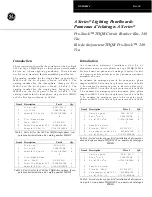
IB 6.2.11.1-2C
Page 3
ABB
INTRODUCTION
The KP-32/40 family of circuit breakers are low voltage
AC power circuit breakers featuring draw-out
construction and the MPSC-2000 microprocessor-
based trip system with RMS sensing. These circuit
breakers can be furnished with either electrically
operated (EO) or manually operated (MO)
mechanisms. On EO models, various control power
combinations are available, and numerous options are
available for both mechanism styles.
These instructions apply to the ANSI-rated “KP” series
(KP-32 and KP-40), and the extended-rated “KPE”
series (KPE-32 and KPE-40).
An electrically operated, drawout type circuit breaker is
shown in Figure 1, with a typical schematic diagram
shown in Figure 2.
These instructions should be read thoroughly before
handling, installing and/or operating the circuit breaker.
RECEIVING AND STORAGE
Immediately upon receipt of the circuit breakers,
examine the cartons to determine if any damage or loss
was sustained during transit. If injury or rough handling
is evident, file a damage claim at once with the carrier
and promptly notify the nearest District Office. The
Company is not responsible for damage of goods after
delivery to the carrier. However, the Company will lend
assistance if notified of claims.
Unpack the circuit breakers as soon as possible after
receipt. If unpacking is delayed, difficulty may be
experienced in making a claim for damages not evident
upon receipt. Use care in unpacking in order to avoid
damaging any of the circuit breaker parts. Check the
contents of each carton against the packing list before
discarding any packing material. If any shortage of
material is discovered, promptly notify the nearest
District Office. Information specifying the purchase
order number, carton number and part numbers of the
damaged or missing parts should accompany the
claim.
Circuit breakers should be installed in their permanent
location as soon as possible (see Basic Handling
below). If the breakers are not to be placed in service
for some time, it is advisable to provide adequate
means of protection. This may he done by keeping the
breaker in its original carton, covering with waterproof
paper and sealing to prevent infiltration of dirt. Where
conditions of high humidity prevail, the use of heaters is
recommended.
BASIC HANDLING
Once the circuit breaker has been unbolted and
removed from its shipping carton, it should be turned
to the upright position and placed on a flat surface to
avoid damage to breaker parts. For safety, all
handling in this position should utilize the lifting yoke
(9) shown in Figure 1.
CIRCUIT BREAKER RATING
The circuit breaker continuous current rating (in
hundreds of amps) is given by the number which
follows the type designation (e.g., KP-40 = 4000A). If
required, the breakers can be fitted with lower ampere
current sensors and trip systems, which provide
tripping below the actual continuous current rating of
the frame size.
Exceeding the continuous current rating of the circuit
breaker for extended periods may raise the
temperature of the circuit breaker beyond the limits
set forth in ANSI C37.13 thus affecting the life of the
circuit breaker insulating materials. The MPSC-2000
trip system has a tolerance band on long time of
minus zero, plus ten percent (-0, +10%) which will
allow the circuit breaker to carry its rated continuous
current but will provide tripping above that value.
Additionally, root mean square (RMS) current
calculation on the long time trip element provides
tripping based on the true heating value of the current
passing through the circuit breaker.
ESCUTCHEON OPERATlNG FEATURES
Manually and electrically operated circuit breakers are
provided with an extended escutcheon face plate.
This escutcheon provides a central area for the
controls which are mounted directly on the circuit
breaker. Figure 1 shows the controls and other
features provided on a typical electrically operated
circuit breaker. The controls for manually operated
circuit breakers are the same, except that the manual
charging handle (16) is standard and the charge
motor and its cut-off switch are not provided.
A self-aligning plate, immediately behind the
escutcheon face plate, is used to exclude dust from
the circuit breaker compartment. The escutcheon
face will protrude through the front door of the
compartment when the circuit breaker is in the “TEST”
and "DISCONNECTED" positions. In these positions,
the dustplate still functions to exclude dust.




































